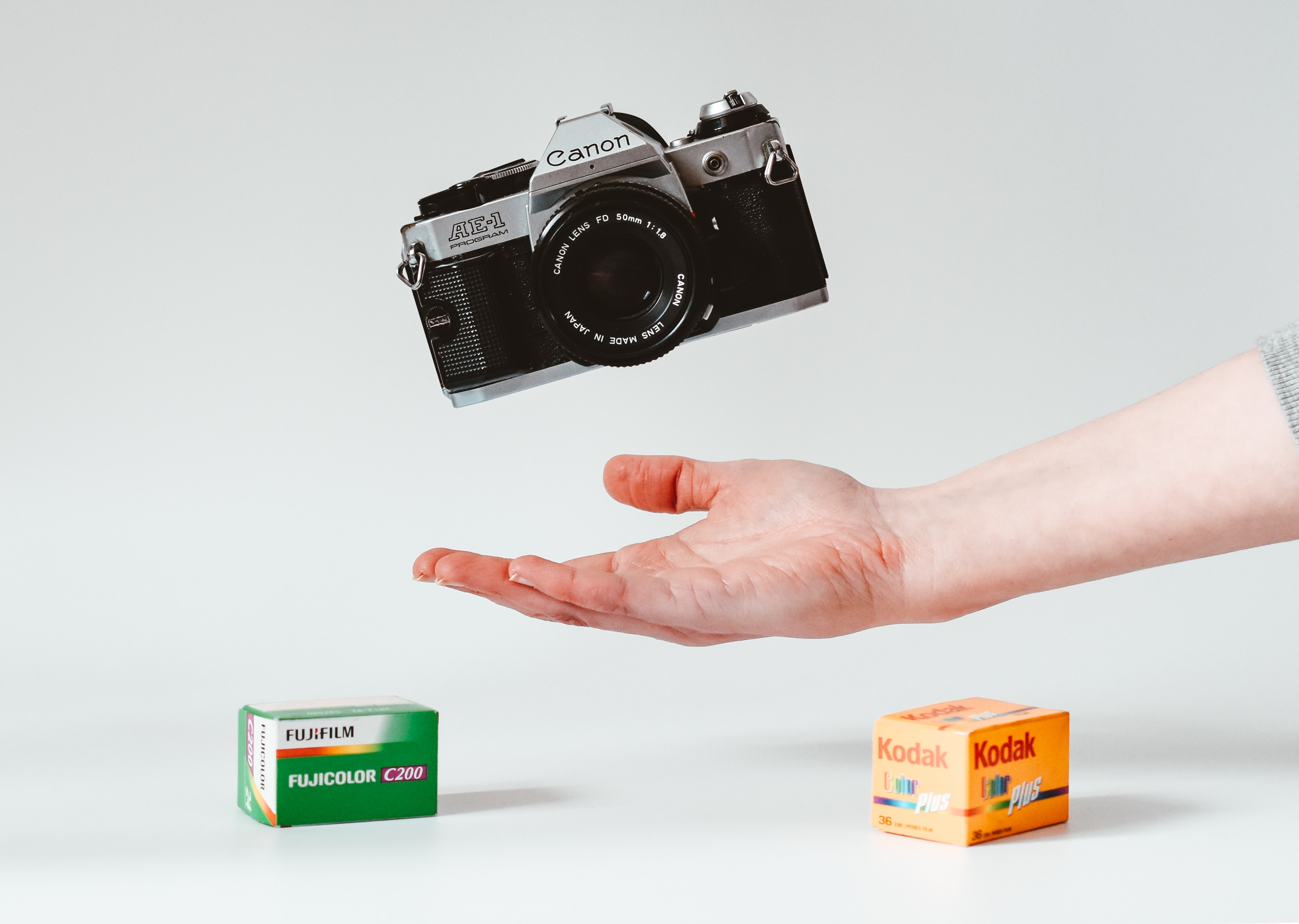Two of our resident film photography enthusiasts at Orms recently put two popular Kodak film stocks to the test in a head-to-head comparison: Portra 400 vs Ultramax 400! Jess, our Content Manager, has been shooting almost exclusively on film for nearly two years, while Sam, our Junior Audiovisual Content Producer, is newer to the wonderful world of analogue.
Armed with 50mm f/1.8 lenses and an Olympus OM-1 and OM-2 respectively, they headed out for an adventure in and around Cape Town. The aim was to capture a two rolls of images on each of these iconic film stocks as a means of comparing their similarities and differences.
Trying to figure out if you are better suited to analogue or digital photography? Take our super fun and super easy quiz to find out!
Kodak Portra 400
Price: R250 per roll

Portra 400 was introduced to Kodak’s range of film stocks in 1998 to replace their Vericolor film. It was intended for use by professional wedding and portraiture photographers. When Portra 400 was originally launched, there were two versions of the film stock: Natural, a very neutral-looking version, and then the Vivid variation, which produced more saturated colours.
Kodak updated the film stock in 2010, merging the Natural and Vivid colour versions into a singular option. This was done with the assumption that most photographers were doing the vast majority of their colour adjustments digitally in the post-processing stage, and therefore it was unnecessary to have two completely separate versions of the film stock.
When Portra 400 was first released, Kodak stated that it was the finest colour grain of any 400 speed film. The gentleness of the grain produces beautifully clear images when correctly exposed. Portra 400 has clear, warm tones, vivid saturation, and excellent skin tone reproduction, making it perfectly suited to portrait photography, and the first choice for many consumers and professionals alike. It is a great option for shooting outdoors with natural light.
If you’re already exploring the film photography field, you can read up on the best tips we have for snapping better analogue shots.
Kodak Ultramax 400
Price: R145 per roll

Predated by Kodak’s Gold range which was introduced to the market in 1988, Ultramax 400 was launched in 1997. It became a fast favourite amongst analogue shooters due to its widespread accessibility and affordability. Unlike Portra 400, Ultramax was marketed as a consumer film stock that — while being cost-effective — was still capable of producing stills of a similar look and feel to Portra 400.
Ultramax 400 boasts a bold colour profile and an intensely saturated look. While its skin tone reproduction is generally regarded as favourable, they do tend to come out yellower than Portra 400. It is also a lot grainer than Portra 400, even when correctly exposed, and this has caused it to be considered a less professional grade option.
Its perfect application can be found in holiday and travel photography, especially if the shooter would like some variety in the reproduction of their images, as Ultramax is known for being slightly inconsistent from one frame to the next. It performs well in scenes where the photographer has limited control over the lighting, especially considering the versatility of its 400 ASA rating.
Due to its lower price, Ultramax 400 is also favoured by those who are newer to analogue photography and therefore more prone to making mistakes. It also has a wide exposure latitude, meaning it can be pushed (i.e. overexposed) by a stop; this tends to produce a lovely glow effect in the images.
Looking for another affordable film stock to try out on your next photowalk? Find out why Jess, our one of our in-house film fans, uses Fujicolor C200 as her go-to film stock.
Side-By-Side Comparison: Portra 400 vs Ultramax 400

In this first comparison, we can see the greater levels of saturation in the Ultramax image when compared to the Portra shot, especially in the more shadowy luminance bands. The Portra image is, however, sharper than the Ultramax frame, likely due to the larger grain the Ultramax image masking its sharpness. The presence of the yellower tones is also noted in the Ultramax image.

In this side-by-side lineup, the Ultramax image is a bit overexposed and that has caused it to become flatter and less saturated than the Portra image. Nonetheless, even in this state of overexposure, the warmer, yellow tones come through strongly in the Ultramax shot. This is especially noticeable in the clouds, which are skewing warm instead of being true white. In the Portra image, the colour reproduction seems to be more accurate, and the detail comes through sharply thanks to its correct exposure.

In this portrait comparison, the Portra image is actually the one that is underexposed, while the Ultramax image is a little overexposed. However, even with the underexposure, the Portra shot is less grainy than one might expect. On the other hand, the Ultramax frame is relatively grainy still, particularly in the mid and shadow luminance bands. This is a testament to the nature of Portra 400’s fine grain, which is able to tolerate underexposure reasonably well.

Again in the following side-by-side layout, the general yellowing of Ultramax’s colour profile can be seen, especially in the oar of the rowboat. The Portra image also exhibits detail, and a truer-to-life colour reproduction, particular in the red and orange tones. However, it is nonetheless worth noting these images’ remarkable similarities in terms of colour and tone when correctly exposed — with tightly controlled exposure, an analogue photographer could still produce a professionally passable result on a roll of Ultramax.

As seen above, when correctly exposed, Portra 400 will exhibit greater levels of saturation and contrast than an overexposed Ultramax 400 image. This produces a far punchier result. Additionally, the colour cast in the Ultramax image is particularly noticeable here, while a correctly exposed Portra 400 image showcases a truly beautiful graduation and separation of colours across the luminance bands.

However, it must be remembered that when correctly exposed, Ultramax 400 exhibits incredible saturation, as seen the image above. Along with this, the strength of the warm, yellow tones can be observed in the colour of the rocks and the subject’s skin tone. The Portra 400 image in general has softer, more subtle hues across the full spectrum of colour, producing a more neutral end result.

Once again, the greater levels of detail in the Portra images can be observed in the comparison above. Much of the Ultramax image’s fine detail is lost due to the increased levels of grain, particularly in areas such as the fronds of the palm trees, while the Portra shot presents far more crisply. It also exhibits that aforementioned pleasing graduation and separation of colours across the image.

As a final point, it is worth noting that even though Portra 400 is a professional grade film stock, it will not save you when incorrect exposure occurs, as is the case in this side-by-side comparison. In this instance, the correctly exposed Ultramax 400 image is far more pleasing.
Portra 400 vs Ultramax 400: Which one is for you?
The answer to the question posed above is — as with most things related to aesthetics in film photography — entirely subjective! After shooting on these film stocks for a full day, Jess ended up preferring Ultramax 400 to Portra 400 for its aggressive colours, more noticeable grain and greater texture. On the other hand, Sam, with his background in digital photography, preferred the subtler tones, greater colour separation, and smoother, finer grain of the Portra images.
At the end of the day, it depends on your shooting style, your subject matter, and personal taste. Now that you know what different types of results you can get with each film stock, go out, buy a roll of each and feel free to experiment! The results may surprise you.






